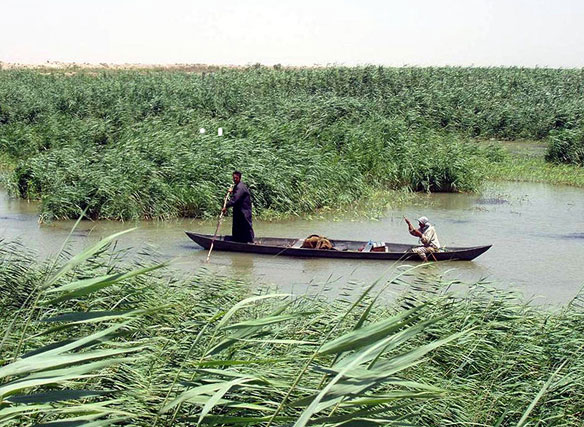
Photo source: NASA
At the northern end of the Persian Gulf is the vast deltaic plain of the Euphrates, Tigris and Karun rivers. A complex of shallow freshwater lakes, swamps, marshes, and seasonally inundated plains between the Tigris and Euphrates make up the largest river delta in the Middle East, the Mesopotamian Delta and Marshes ecoregion, located in southern Iraq and partially in southwestern Iran. Captions source: ©© WWF
The Mesopotamian Marshes are a wetland area Historically the marshlands, mainly composed of the separate but adjacent Central, Hawizeh and Hammar Marshes, used to be the largest wetland ecosystem of Western Eurasia.
Regarded by historians as one of the cradles of civilization, the Mesopotamian Fertile Crescent has supported Marsh Arab society for millennia. NASA. The hydrology of these vast marshes is extremely important to the ecology of the entire upper Persian Gulf. NASA
Excerpts;
The Mesopotamian Marshes, a vast expanse of reeds and open water twice the size of Norfolk, are the largest wetland ecosystem in the Middle East and support a number of species of global conservation concern. The marshes hold the only breeding population of the globally endangered Basra reed warbler and the world’s highest wintering numbers of the threatened marbled duck.
Now the marshes are under threat again, this time from the building of huge dams in Turkey on the Tigris and Euphrates…
Read Full Article “Conservation knows no boundaries…”, Guardian UK
Lessons from Iraq: Urban Marshes and City Survival, Science Daily
A scientist at the University of South Carolina is continuing to build the case that natural wetlands, rather than irrigated fields, are the fertile ground from which cities initially emerged in Mesopotamia. And her conclusions about the importance of wetlands to a sustainable urban environment or, in fact, any environment, have particular resonance in southern Iraq. That area is both the site of her studies and the region where Saddam Hussein forcibly drained marshes to drive out the local populace after the first Gulf war.
Mesopotamian Delta and Marshes, WWF
Vanishing Marshes of Mesopotamia, NASA
Water and life return to Iraq’s ‘Garden of Eden’, Guardian UK
One of Saddam Hussein’s greatest acts of ecological destruction, the draining of the Mesopotamian marshes, left a vast area of once-teeming river delta a dry, salt-encrusted desert, emptied of insects, birds and the people who lived on them. But, nearly two decades later the area is buzzing and twittering with life again after local people and a new breed of Iraqi conservationists have restored much of what was once the world’s third largest wetland to some of its former glory…
Dam Threatens Turkey’s Past and Future, IPS
Turkey’s Dams Are Violating Human Rights, Green Prophet

Marsh Arabs poling a traditional mashoof in the marshes of southern Iraq. Captions and Photo source: ©© Hassan Janali, U.S. Army Corps of Engineers









